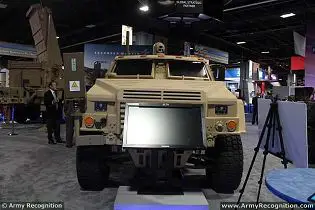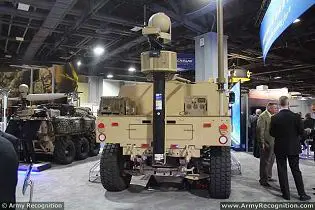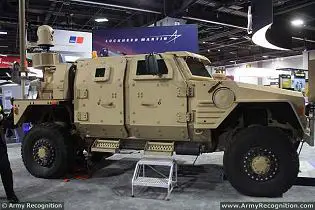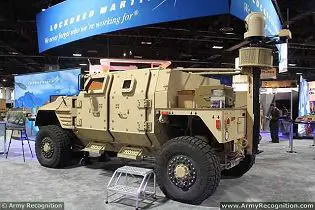Lockheed Martin submitted its proposal for the Technology Development phase of the competition to build the next-generation Joint Light Tactical Vehicle (JLTV) for the U.S. Army and Marine Corps. The proposal, delivered to the services' joint JLTV program office on April 11, offers an integrated approach to military vehicle survivability that combines vehicle design with systems intelligence. The JLTV program will provide the services with a family of expeditionary vehicles capable of on- and off-road mobility that also provide increased levels of protection for the warfighter while remaining fully transportable. The future family of vehicles will comprise five "Mission Role" variants: the Combat Tactical Variant, the Command and Control Variant, the Utility Variant, the Light Infantry Squad Carrier Variant and the Reconnaissance Variant. The vehicle family will also include compatible trailers.
The Lockheed Martin-led JLTV Team includes:
• BAE Systems Mobility & Protection Systems, providing advanced armor solutions and production facilities for high volume assembly;
• Alcoa Defense, supplying materials experience, design services and aluminum components that give the vehicle its structural strength at reduced weight; and
• JWF – Defense Systems, offering state-of-the-art machining and cost-effective fabrication.
Lockheed Martin serves as the prime contractor and design agent, providing systems engineering, platform integration, design expertise and program management. |
| Armament |
|
At this time, there is not specific armament mounted to the vehicle, but in the future the vehicle can be fitted with a 12,7 mm machine gun for his self-protection. The Lockheed Martin vehicle benefits warfighters with features including superior mobility; weapons and countermeasures to neutralize threats; and a new armor composition combined with an innovative hull and structural design for protection if an attack cannot be avoided, said DeSantis.
|
| Protection |
|
The JLTV Lockheed Martin design will include a basic armor protection package as well as provisions to accommodate an additional add-on armor kit. Lockheed Martin will serve as the prime contractor and systems integrator, providing the vehicle design, net-centric capabilities and logistics. Armor Holdings will primarily be responsible for vehicle assembly. Additionally, AHI will lead the design and manufacture of the armor survivability subsystems. Alcoa of Pittsburgh, PA, JWF Industries of Johnstown, PA, and Axletech International of Troy, MI will also provide key support to Lockheed Martin for this opportunity.
Despite its light weight, the vehicles will give warfighters needed force protection capabilities. It can achieve this through an improved v-hull design, which is unique to the Lockheed Martin team, and added armor, which increases lethality and superior mobility. The team is committed to warfighter safety, and government blast testing showed JLTV can beat TD blast protection expectations.
In october 2011 Lockheed Martin announced, recent government blast tests demonstrated that Lockheed Martin’s Joint Light Tactical Vehicle (JLTV) meets protection standards for IED-protected vehicles, while weighing approximately 40 percent less than other all-terrain models deployed in theater.
|
| Mobility |
|
For the vehicle there are several general requirements that have been stipulated by the US Army and Marine Corps.These include a Diesel and hybrid electric versions, with a maximum speed of 125 km/h and a maximum range of 650 km. The engine will provide the primary source of electrical power. The power-plant will also be required to provide external power for dismounted users, during extended silent watch.
|
| Variants |
|
Lockheed Martin currently has three operational prototypes: the JLTV Category B model, which is designed as an infantry carrier and was unveiled in October 2007; the Utility Vehicle Light Category C model, which is designed with a focus on payload and was introduced in February 2008; and the General Purpose Mobility Category A model, which was unveiled earlier this month at the Association of the United States Army’s Annual Meeting and Exhibition.
The JLTV program creates a common family of vehicles consisting of the Combat Tactical Vehicle and Combat Support Vehicle, both with multiple variants. The Lockheed Martin team provides unique, netenabled, integrated vehicles that effectively balance payload, protection, performance, transportability and affordability. During the program’s TD phase the JLTV team delivered 10 TD vehicles in three payload categories and five companion trailers to the U.S. government, including two Right Hand Operation JLTV vehicles and one companion trailer to the Australian military.
|
| |
| Specifications |
| Back to top |
|
Armament
|
|
The basic version can be fitted with a 7,62 mm or 12,7 mm machine gun.
|
|
Country users
|
|
United States
|
|
Designer Company
|
|
Lockeed Martin, Alcoa Defense, and JWF – Defense Systems
|
|
Accessories
|
|
Requirements : Jam-resistant doors, automatic fire-extinguishing system, two run-flat tyres, Electronic monitoring to diagnose equipment and system failures
|
|
|
Armor
|
|
Basic armor, with additional add-on armour kit.
a
|
|
Weight
|
|
7,030 kg
|
|
Speed
|
|
105 km/h
a
|
|
Range
|
|
650 km
a
a
|
|
|
| |
|
































